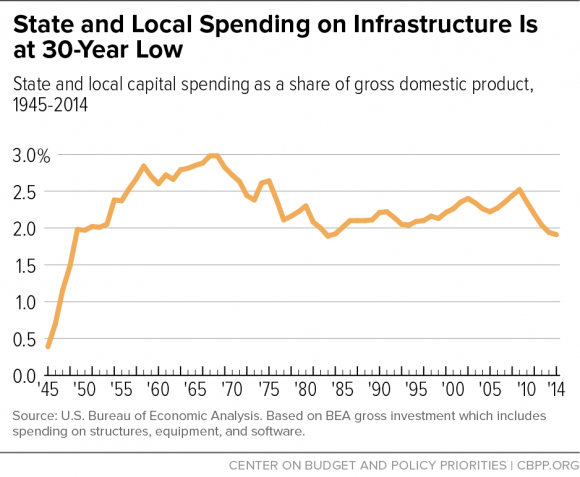Last December Congress finally pushed through a $305 billion, five-year highway and transit bill after years of delay and neglect of the nation’s roads and infrastructure.
However, despite the celebration by lawmakers and state and local officials who have long sought the increased spending, the legislation was little more than a drop in the bucket when compared to the nation’s overall infrastructure needs.
Related: Why Infrastructure Investment Is a No-Brainer Payoff
A new report this week by the Center on Budget and Policy Priorities warns that state and local spending on infrastructure – including schools and wastewater treatment plants as well as highways and bridges – is at a 30-year low. Total capital spending as a share of state GDP fell in all but five states and the District of Columbia between 2002 and 2013, with the largest drops in Nevada, Florida and Michigan.
According to the 2013 report card by the American Society of Civil Engineers, the U.S. has serious infrastructure needs of more than $3.4 trillion through 2020, including $1.7 trillion for roads, bridges and transit; $736 billion for electricity and power grids; $391 billion for schools; $134 billion for airports; and $131 billion for waterways and related projects.

A big part of the problem is that federal investment in infrastructure has dropped by half during the past three decades, from 1 percent to 0.5 percent of GDP, leaving more of the responsibility and finances to state and local governments.
At the same time, states have varied greatly on how much of their annual budgets they have been willing to invest in infrastructure – from as little as 3 percent to 4 percent of total state spending in California, Michigan and Vermont to as much as 9 percent in Alabama, Montana and Nebraska.
The new report, written by senior fellow Elizabeth McNichol, says that reversing the relentless decline in state investment in transportation, public buildings and other forms of vital infrastructure “is the key to creating good jobs and promoting full economic recovery,” especially at a time of improved economic conditions and historically low interest rates.
Related: The House Resorts to More Gimmicks to Pass $325 Billion Highway Bill
But instead of making the infrastructure investments essential to building a stronger economic recovery, the report says, many states have opted instead for cutting taxes and offering corporations tax subsidies in a “misguided approach to boosting economic growth.”
“Tax cuts will spur little to no economic growth and take money away from schools, universities, and other public investments essential to producing the talented workforce that businesses need,” the report contends. “This pattern of neglect of infrastructure by states — the primary stewards (along with their local government partners) of the nation’s infrastructure — has serious consequences for the nation’s growth and quality of life as roads crumble, school buildings become obsolete, and outdated facilities jeopardize public health.”
A handful of states are addressing the need for infrastructure investment. For instance, Connecticut and Washington have launched multi-year, multi-stage transportation improvement initiatives. And last year more than ten states, including Idaho and Georgia, raised their gas tax to fund road construction – something Congress has refused to do.

“But overall, states are cutting infrastructure spending as a share of the economy, the opposite of what is needed,” the CBPP report states.
Related: Infrastructure Now, or Apologize for It Forever
In an interview on Wednesday, McNichol praised Congress for finally beginning to address the infrastructure crisis, but described last year’s legislation as only a modest step.
“I would say it is a step in the right direction, but there’s a lot more that needs to be done,” she said. “And state and local governments are the key players here. They own 93 percent of public non-defense buildings and structures.”






